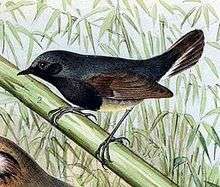Blackthroat
| Blackthroat | |
|---|---|
 | |
| Scientific classification | |
| Kingdom: | Animalia |
| Phylum: | Chordata |
| Class: | Aves |
| Order: | Passeriformes |
| Family: | Muscicapidae |
| Genus: | Calliope |
| Species: | C. obscura |
| Binomial name | |
| Calliope obscura (Berezowski & Bianchi , 1891) | |
| Synonyms | |
|
Luscinia obscura | |
The blackthroat (Calliope obscura), also known as the black-throated robin or black-throated blue robin, is a species of bird in the family Muscicapidae. It breeds in north-central China but its wintering grounds are uncertain. It has been recorded as a vagrant in northwest Thailand. Its natural habitat is bamboo thickets within coniferous forest at altitudes of 3000–3,400 metres. It is threatened by habitat loss.
The species was discovered in 1891, but for the next 120 years only a handful of individuals were seen.: even now no female has been conclusively identified. So little was known of it that it earned the title " Asia's most enigmatic robin".[2]
In June 2011 a team of scientists discovered its breeding grounds in the Qinling Mountains, Shaanxi Province, north central China. Seven singing males were seen in Foping and a further seven in Changqing Nature Reserves- almost equal to the total number seen previously.[3]
In 2014 a female and breeding pair were sighted.[4]
The blackthroat was previously placed in the genus Luscinia. A large molecular phylogenetic study published in 2010 found that Luscinia was not monophyletic. The genus was therefore split and several species including blackthroat were moved to the reinstated genus Calliope.[5][6]
References
- ↑ BirdLife International (2013). "Luscinia obscura". IUCN Red List of Threatened Species. Version 2013.2. International Union for Conservation of Nature. Retrieved 26 November 2013.
- ↑ Qian, W.; Yi, H. (2011). "First images in the wild of Blackthroat Luscinia obscura, Asia's most enigmatic robin" (PDF). BirdingASIA. 15: 17–19.
- ↑ BBC Nature 15/12/2011
- ↑ "Rare blackthroated blue robins spotted in China". BBC News. Retrieved 8 April 2014.
- ↑ Sangster, G.; Alström, P.; Forsmark, E.; Olsson, U. (2010). "Multi-locus phylogenetic analysis of Old World chats and flycatchers reveals extensive paraphyly at family, subfamily and genus level (Aves: Muscicapidae)". Molecular Phylogenetics and Evolution. 57 (1): 380–392. doi:10.1016/j.ympev.2010.07.008.
- ↑ Gill, Frank; Donsker, David, eds. (2016). "Chats, Old World flycatchers". World Bird List Version 6.2. International Ornithologists' Union. Retrieved 20 May 2016.
Further reading
- Alström, P.; Song, G.; Zhang, R.; Gao, X.; Holt, P.I.; Olsson, U.; Lei, F. (2013). "Taxonomic status of Blackthroat Calliope obscura and Firethroat C. pectardens" (PDF). Forktail. 29: 94–99.
- Song, G.; Alström, P.; Zhang, R.; Gao, X.; Gong, H.; Holt, P.I.; Quan, Q.; Yin, Z.; Lei, F. (2014). "Rediscovery of an enigmatic Chinese passerine, the Blackthroat Calliope obscura: plumage, vocalizations, distribution, habitat choice, nesting and conservation". Journal of Ornithology. 155: 347–356. doi:10.1007/s10336-013-1009-5.
- Round, P.D.; Clement, P. (2015). "Firethroat Calliope pectardens and Blackthroat C. obscura: notes on winter plumages and habitats". 23: 84–87.
- Alström, P.; Zhao, M.; He, P.; Lei, F. (2016). "New locality for the endangered Blackthroat Calliope obscura". Journal of Ornithology. 157: 371–372. doi:10.1007/s10336-015-1279-1.
